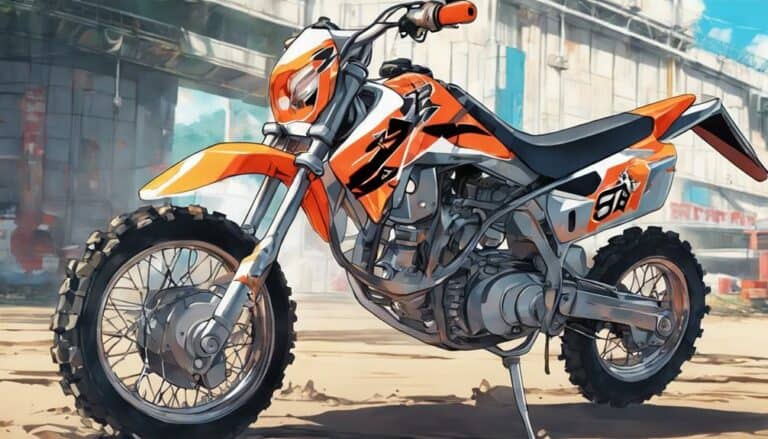When it comes to your dirt bike rim, understanding the max runout is like finding the needle in a haystack – essential yet often overlooked.
You might be wondering why this measurement matters so much and how it impacts your overall riding experience.
Let's uncover the significance of max runout on a dirt bike rim and how it can make a difference in your off-road adventures.
Key Takeaways
- Max runout on dirt bike rims affects stability and safety during rides.
- Measuring runout accurately ensures high-quality performance and safety.
- Common causes include mounting errors, accidents, and spoke issues.
- Correct runout by evaluating spoke tension and performing truing adjustments meticulously.
Understanding Max Runout on Dirt Bike Rim
To grasp the significance of max runout on a dirt bike rim, understand that it directly impacts the stability and safety of your ride.
The rim of your dirt bike plays an essential role in maintaining proper handling and safety while riding off-road.
Maximum runout refers to the acceptable limit of deviation in the rim's roundness, with recommended values typically being less than 1/16 inch or 0.060 inches in any direction.
Exceeding this limit can lead to unstable handling, vibrations, and potentially dangerous situations.
To guarantee the best performance and safety of your dirt bike, it's essential to regularly check and adjust the runout on your rim.
Importance of Measuring Runout Accurately
Accurately measuring runout on a dirt bike rim is important for ensuring high-quality ride quality and safety. To achieve this, utilize a dial indicator on a truing stand to measure both lateral and radial runout. Lateral runout refers to side-to-side deviation, while radial runout indicates up-and-down movement.
Proper tensioning of spokes and precise rim truing are essential in minimizing runout. When building a wheel, precise measurements and tightening of spokes play a critical role in reducing runout. Detecting and correcting runout issues promptly can prevent vibrations and instability while riding.
Maintaining runout within acceptable limits enhances the overall performance of the dirt bike, ensuring a smooth and safe riding experience. By focusing on accurate measurements and adjustments during wheel building, you can optimize the alignment and performance of your dirt bike, promoting a more enjoyable and secure ride.
Common Causes of Runout in Dirt Bike Rims
Common causes of runout in dirt bike rims often stem from impact damage incurred while riding on rough terrain. To dig deeper into this issue, consider the following factors:
- Important Installation: Errors in mounting the wheel or tire can lead to runout problems.
- Warped or Bent Rims: Accidents or collisions can result in lateral runout issues.
- Spoke Issues: Loose or broken spokes can contribute to runout problems.
- Tensioning Problems: Over-tightening or uneven tensioning of spokes during maintenance can cause runout.
- External Impact: Any forceful impact on the rim's side can also lead to runout.
Understanding these common causes can help you prevent runout on your dirt bike rim. In the next section, we'll explore how to accurately measure runout using a dial indicator and identifying important measurement points on the rim.
How to Measure Runout on Your Dirt Bike Rim
Using a dial gauge, accurately measure radial and lateral runout on your dirt bike rim to guarantee peak performance. Begin by securing the dial indicator on a stable surface near the rim. Rotate the wheel slowly and observe the needle to determine radial runout, ensuring it stays within 1/32 of an inch for peak performance.
Next, check lateral runout by moving the gauge to the side of the rim and making sure it falls between 5 to 8 thousandths of an inch. If you notice any deviations, inspect the spokes for proper tension and tighten or adjust them accordingly.
Take multiple measurements at different points around the rim to get a thorough understanding of the runout. Excessive runout can cause vibrations and impact the handling of your dirt bike, so regular monitoring and correction are essential for a smooth and safe riding experience.
Tips for Correcting Runout Issues on Rims
To address runout issues on your dirt bike rim effectively, start by evaluating the tension of the spokes to guarantee proper alignment and balance. Here are some tips for correcting runout problems on your rims:
- Use a dial indicator to measure radial runout and make sure it's within the specified tolerance.
- Perform lateral truing by adjusting the spokes to minimize lateral runout, aiming for 5 to 8 thou.
- Check for even tension across all spokes and tighten any loose ones to maintain balance.
- Keep an eye on the rim runout and aim for a maximum of 1/32 to ensure precision.
- When correcting runout, focus on achieving tight tolerances like +/- .001 in. for high-end rims, or +/- .002 in. for entry-level to mid-range rims to optimize performance on your dirt bike.
Conclusion
Optimal, ensuring your dirt bike rim has minimal runout is like aligning the stars for a smooth ride. By accurately measuring and correcting any deviations in alignment, you can prevent issues such as vibrations or wobbling while riding off-road.
Remember to follow proper truing techniques and use the right tools to maintain optimal performance and safety on your dirt bike.

